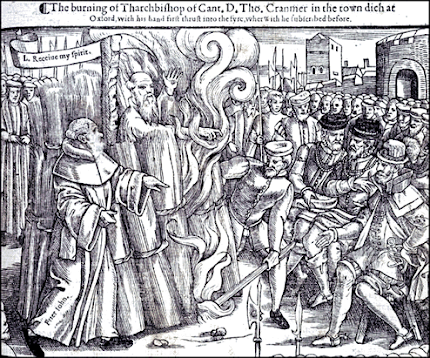Through much of his career, Cranmer seems to have been engaged in a quest to define the nature of a sacrament and what it signifies. Jeanes picks up the trail in the late 1530s, drawing on an awe-inspiring range of material. Discussion of contemporary documents, including the anonymous, but probably Cranmerian treatise, De Sacramentis (which the author has edited), ancient sources, a large corpus of secondary literature (some of it usefully re-examined) and very recent publications ensures an invaluable presentation of the current state of research. Here, we see the beginnings of the Archbishop’s commitment to a sacramental theology that keeps both dominical sacraments in view. Indeed, it is Jeanes’s contention throughout that Cranmer’s thinking on baptism and the Eucharist was closely interlinked. In particular, his understanding of consecration, sacramental grace and growth in the Christian life involve parity between the major symbolic components – bread, wine and water – as well as between eating and drinking at the Eucharist, and the application of water in baptism.
This leads unavoidably to the question of sacramental presence, and Jeanes illustrates Cranmer’s not always successful attempts to employ analogies showing that the substance of the thing signified need not participate in the sign, though its benefits could be indicated and conveyed. The fact that Cranmer often used words in a sense different from that intended by his fellow-Reformers (‘seal’ in the case of baptism is a prominent example) adds a further degree of complexity.By the end of the 1530s, Cranmer was articulating a view of sacramental efficacy as God’s work, by grace conveyed by the Holy Spirit, in the recipient. Christ is spiritually present in the faithful recipient – a strong Christological emphasis rather unfortunately subduing the pneumatological element in Jeanes’s view. Jeanes shows Cranmer working with an idea of sacramental grace that is developmental; in other words, grace acts in the recipient over time.
Hence his emphasis on signification: the sacraments are signs of God’s promise of grace. They neither presuppose grace already present in the recipient, nor confer grace at the time of reception – views which, broadly speaking, might be said to be represented respectively by Bucer and Calvin. In Cranmer’s thought, they are a sign that God’s grace is offered to the faithful eucharistic recipient and the candidate for baptism. This is why parents and godparents can make promises on the child’s behalf, just as it explains why the priest may, in 1552, take the remaining bread and wine home for his own use.
From: Signs of God's Promise




No comments:
Post a Comment